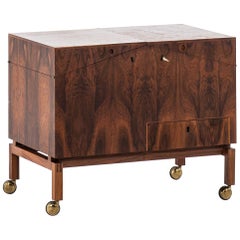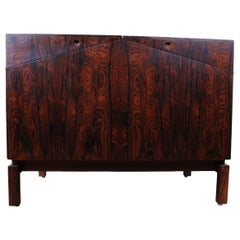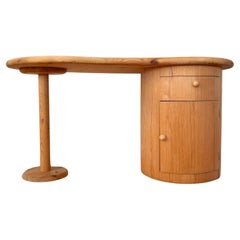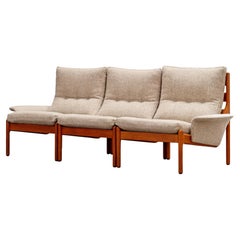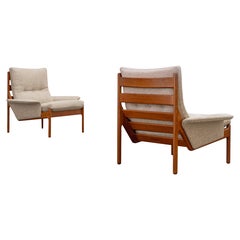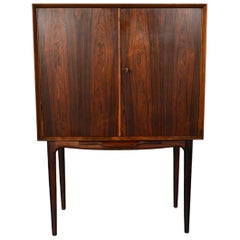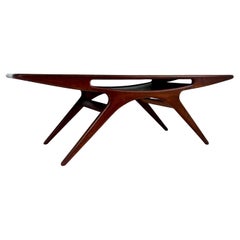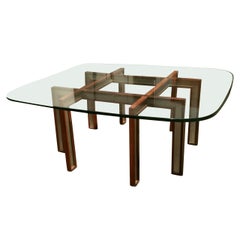C F Christensen
to
8
85
51
146
131
86
17
9
2
1
1
62
46
44
15
10
Sort By
Kidney-shaped design desk by C. F. Christensen Silkeborg, Denmark 1970
By CFC Silkeborg
Located in Breda, NB
Kidney-shaped desk by C. F. Christensen Silkeborg, Denmark 1970. This kidney-shaped desk
Category
Vintage 1970s Danish Desks
Materials
Wood
$1,919
H 29.14 in W 56.7 in D 30.32 in
Leif Alring Bar Cabinet Model 284 Produced by C.F. Christensen in Denmark
By Leif Alring
Located in Limhamn, Skåne län
Rare bar cabinet model 284 designed by Leif Alring. Produced by C.F. Christensen in Denmark.
Category
Vintage 1960s Danish Scandinavian Modern Dry Bars
Materials
Brass
$7,803
H 22.84 in W 27.56 in D 17.72 in
Danish Modern Folding Bar Cabinet by Leif Alring for c.f. Christensen
By Leif Alring
Located in North Hollywood, CA
Amazing Brazilian rosewood Danish modern folding bar cabinet designed by Leif Alring for C.F
Category
Vintage 1960s Danish Mid-Century Modern Coffee and Cocktail Tables
Materials
Rosewood
$3,720 Sale Price
28% Off
H 21 in W 55 in D 18 in
Kidney-shaped design desk by C. F. Christensen Silkeborg, Denmark 1970
By CFC Silkeborg
Located in Radomsko, Województwo łódzkie
This kidney-shaped desk by CFC Silkeborg, designed in 1970, is a fine example of Danish craftsmanship from the era. Its smooth, organic shape reflects the focus on simplicity and fun...
Category
Mid-20th Century Desks and Writing Tables
Materials
Pine
$1,920
H 28.35 in W 57.09 in D 29.14 in
Teak Sofa "Venus" by Illum Wikkelsø for C F Christensen Silkeborg, 1972
By Illum Wikkelsø, CFC Silkeborg
Located in Rosendahl, DE
Sofa designed by Illum Wikkelsø for Silkeborg, 1972. Solid teak wood with a curved frame. Danish design from the 1970s with high-quality craftsmanship.
We can organize fast shipping...
Category
Mid-20th Century Danish Scandinavian Modern Sofas
Materials
Fabric, Teak
$8,884
H 31.5 in W 88.98 in D 31.11 in
Pair of Lounge Chairs by Illum Wikkelsø for C F Christensen Silkeborg, 1972
By CFC Silkeborg, Illum Wikkelsø
Located in Rosendahl, DE
Pair of Lounge Chairs, designed by Illum Wikkelsø for Silkeborg, 1972. Solid teak wood with a curved frame. Danish design from the 1970s with high-quality craftsmanship.
We can orga...
Category
Mid-20th Century Danish Scandinavian Modern Sofas
Materials
Fabric, Teak
$9,004 / set
H 31.5 in W 37.8 in D 31.11 in
Illum Wikkelso Bar in Rosewood With Etched Mirrored Interior
By Illum Wikkelsø, Johannes Andersen and C. F. Christensen
Located in Berkeley, CA
Origin: Denmark
Designer: Illum Wikkelsø
Manufacturer: C. F. Christensen
Era: 1960s
Materials
Category
Mid-20th Century Danish Mid-Century Modern Credenzas
Materials
Rosewood
Johannes Andersen CFC Silkebørg Smile Coffee Table, 1950s Denmark
By Johannes Andersen and C. F. Christensen, Johannes Andersen
Located in Miami, FL
"Smile" coffee table by Johannes Andersen and Johannes Andersen and C. F. Christensen for Silkebørg. The
Category
Vintage 1950s Danish Scandinavian Modern Coffee and Cocktail Tables
Materials
Teak
Rosewood and Brushed Steel Cocktail Table by Henning Korch
By Henning Korch
Located in Buffalo, NY
Beautiful Rosewood and Brushed Steel cocktail table by Henning Korch for C.F. Christensen
Category
Vintage 1960s Danish Mid-Century Modern Coffee and Cocktail Tables
Materials
Stainless Steel
Teak Bar Cabinet with Harlekin Mirrors by Illum Wikkelsø
By Illum Wikkelsø
Located in Handewitt, DE
Cocktail or bar cabinet cabinet, designed by Illum Wikkelsø for C.F. Christensen Denmark. Made in
Category
Mid-20th Century Danish Scandinavian Modern Cabinets
Materials
Mirror, Teak
Living Room Set Model Plexus by Illum Wikkelsø for CFC Silkeborg, 1960
By Illum Wikkelsø, CFC Silkeborg
Located in Los Angeles, CA
Wonderful living room set designed by Illum Wikkelsø for C.F. Christensen, Silkeborg, in Denmark
Category
Vintage 1960s Danish Scandinavian Modern Living Room Sets
Materials
Upholstery, Wicker, Oak
$6,600 / set
H 27.56 in W 76 in D 27.56 in
Illum Wikkelso Teak and Smoked Glass Large Coffee Table, 1960s
By Illum Wikkelsø
Located in Bainbridge, NY
Danish Modern Illum Wikkelso for C. F. Christensen teak coffee table with smoked gray glass surface
Category
Vintage 1960s Danish Scandinavian Modern Coffee and Cocktail Tables
Materials
Glass, Teak
Double Trestle Danish Teak Coffee Table by CFC Silkeborg
By CFC Silkeborg, Illum Wikkelsø
Located in Brooklyn, NY
Exceptionally rare coffee table by CFC (C.F. Christensen) Silkeborg, one of Denmark's most
Category
Mid-20th Century Danish Mid-Century Modern Coffee and Cocktail Tables
Materials
Wood, Hardwood, Teak
1960 Illum Wikkelso Fully Restored Danish Oak Plexus Side Table by CFC Silkeborg
By Illum Wikkelsø, CFC Silkeborg
Located in Knebel, DK
chair and his easy chair model V11.
An important partner was C. F. Christensen, Silkeborg, for whom he
Category
Vintage 1960s Danish Scandinavian Modern Side Tables
Materials
Oak
$840 / item
H 20.87 in W 36.23 in D 36.23 in
1960s Illum Vikkelso Danish Plexus Easy Chairs in Mahogany and White Fabric
By Illum Wikkelsø, CFC Silkeborg
Located in Knebel, DK
chair model V11.
An important partner was C. F. Christensen, Silkeborg, for whom he designed the
Category
Late 20th Century Danish Scandinavian Modern Armchairs
Materials
Mahogany
$2,221 / set
H 25.6 in W 29.14 in D 24.02 in
Rosewood Johannes Andersen for CF Christensen of Silkeborg Nesting Tables
By Johannes Andersen and C. F. Christensen, Johannes Andersen
Located in Oakland, CA
Set of three rosewood nesting tables designed by Johannes Andersen produced by CF Christensen of
Category
Vintage 1950s Danish Scandinavian Modern Nesting Tables and Stacking Tables
Materials
Rosewood
$2,400 / set
H 20 in W 23.63 in D 14.18 in
Set of Two Illum Vikkelso Danish Plexus Easy Chairs in Mahogany by CFC Silkeborg
By CFC Silkeborg, Illum Wikkelsø
Located in Knebel, DK
easy chair model V11.
An important partner was C. F. Christensen, Silkeborg, for whom he designed the
Category
Late 20th Century Danish Scandinavian Modern Armchairs
Materials
Mahogany
$3,001 / set
H 25.6 in W 29.14 in D 24.02 in
Mid-Century Modern Danish Lounge Chair and Foot Stool
By Illum Wikkelsø
Located in Point Richmond, CA
designs, such as C.F. Christensen, Holger Christiansen, Eilersen, Farstrup, Silkeborg, and Søren Willadsen.
Category
Vintage 1960s Danish Mid-Century Modern Armchairs
Materials
Leather
Illum Wikkelsø Armchair Model "Australia" Denmark 1960
By Illum Wikkelsø
Located in Paris, FR
Wikkelsø’s designs, such as C.F. Christensen, Holger Christiansen, Eilersen, Farstrup, Silkeborg, and Søren
Category
Vintage 1960s Danish Mid-Century Modern Armchairs
Materials
Wool, Rosewood
1960s Set of Two Illum Vikkelso Plexus Easy Chairs in Rosewood by CFC Silkeborg
By Illum Wikkelsø, CFC Silkeborg
Located in Knebel, DK
easy chair model V11.
An important partner was C. F. Christensen, Silkeborg, for whom he designed the
Category
Late 20th Century Danish Scandinavian Modern Lounge Chairs
Materials
Rosewood
$3,601 / set
H 24.81 in W 29.14 in D 27.17 in
Danish Modern Johannes Andersen teak draw leaf dining table 8.5 ft
By Johannes Andersen and C. F. Christensen
Located in Las Vegas, NV
Danish Modern Johannes Andersen teak draw leaf dining table for Uldum Møbelfabrik. Features two 19.5" draw leaves. Can seat 8-10 .
With both leaves in 102 in. each leaf is 19.5
Ta...
Category
Vintage 1960s Danish Mid-Century Modern Dining Room Tables
Materials
Teak
Danish Expandable Teak Coffee Table Designed by Johannes Andersen
By Johannes Andersen and C. F. Christensen
Located in Las Vegas, NV
Expandable teak coffee table designed by Johannes Andersen and produced by CFC Silkeborg.
Featuring beautiful teak woodgrain, sculptural solid teak legs and expandable table exten...
Category
Vintage 1960s Mid-Century Modern Coffee and Cocktail Tables
Materials
Teak
Johannes Andersen's Teak Side Table for CFC a Danish Mid-Century Masterpiece
By Johannes Andersen and C. F. Christensen
Located in Copenhagen, DK
Exquisite find for enthusiasts of mid-century design: an Early Johannes Andersen Teak Side Table from 1960. This rare gem boasts an early CFC Silkeborg brandmark underneath, a testam...
Category
Vintage 1960s Danish Mid-Century Modern Side Tables
Materials
Teak
$2,040
H 23.63 in W 23.63 in D 13.39 in
Johannes Andersen Coffee Table, Cf Christenson Silkeborg
By Johannes Andersen and C. F. Christensen
Located in Vienna, AT
Organic shaped coffee table with tapered solid wood legs, designed in the 1060s by Johannes Andersen for CFC Silkeborg in Denmark. Very good original condition.
Category
Vintage 1960s Danish Scandinavian Modern Coffee and Cocktail Tables
Materials
Hardwood
Danish Nest of Tables Johannes Andersen for CFC Mobler Silkenborg
By Johannes Andersen and C. F. Christensen
Located in New York, NY
Sleek Danish modern nest of three teak tables by Johannes Andersen for CFC Mobler Silkeborg. Dimensions in listing are for the largest table.
Category
Vintage 1960s Danish Scandinavian Modern Nesting Tables and Stacking Tables
Materials
Teak
$1,450 / set
H 20.5 in W 23.5 in D 14.25 in
Illum Wikkelsø "V11" Brown Leather Sofa for Holger Christiansen, Denmark 1960s
By Illum Wikkelsø
Located in Utrecht, NL
established his own workshop. A number of Danish manufacturers produced Wikkelsø’s designs, such as C.F
Category
Vintage 1960s Danish Mid-Century Modern Sofas
Materials
Leather, Wood
$17,500
H 26.78 in W 91.34 in D 31.89 in
“Model V11” Three-Seater Leather Sofa by Illum Wikkelsø, Denmark, 1960s
By Illum Wikkelsø, Holger Christiansen
Located in Utrecht, NL
. A number of Danish manufacturers produced Wikkelsø’s designs, such as C.F. Christensen, Holger
Category
Vintage 1960s Danish Scandinavian Modern Sofas
Materials
Leather, Wood
$17,500
H 27.56 in W 91.34 in D 32.88 in
Illum Wikkelsø Model V11 Leather Sofa for Holger Christiansen, Denmark, 1960s
By Illum Wikkelsø, Holger Christiansen
Located in Utrecht, NL
. A number of Danish manufacturers produced Wikkelsø’s designs, such as C.F. Christensen, Holger
Category
Vintage 1960s Danish Mid-Century Modern Sofas
Materials
Leather, Wood
$15,500
H 26.78 in W 85.04 in D 31.3 in
Bar Cart / Serving Trolley in Teak/Formica, Designed by C.F. Christensen
By Johannes Andersen and C. F. Christensen
Located in Mørkøv, 85
.
Produced by C.F. Christensen, Silkeborg in 1960s.
In a good an original condition, with signs of wear and
Category
Vintage 1960s Danish Mid-Century Modern Serving Tables
Materials
Formica, Teak
$1,500
H 22.45 in W 36.23 in D 22.45 in
Rare Big Ottoman Model 272 Designed by Illum Wikkelsø for C.F. Christensen
By CFC Silkeborg, Illum Wikkelsø
Located in Helsingborg, SE
Rare big ottoman / footstool model 272 in teak with black saddle leather by Illum Wikkelsø for C.F
Category
Vintage 1960s Danish Scandinavian Modern Stools
Materials
Leather, Teak
$2,040
H 17.33 in W 23.63 in D 23.63 in
Henning Korch Wooden Serving Bar Cart for C.F. Christensen, Denmark, 1960s
By Johannes Andersen and C. F. Christensen, Henning Korch, CFC Silkeborg
Located in Vienna, AT
Trolley table in hardwood rosewood designed by Henning Korch, Denmark 1960s.
Category
Vintage 1960s Danish Scandinavian Modern Carts and Bar Carts
Materials
Hardwood
$3,361
H 26.78 in W 28.15 in D 18.51 in
Illum Wikkelsø Pair of Stools Model 272
By Illum Wikkelsø
Located in Copenhagen, DK
Illum Wikkelsøe pair of stools made in teak and leather.
Manufacturer: C.F. Christensen.
Category
Vintage 1960s Danish Scandinavian Modern Stools
Materials
Leather, Teak
Bar Cabinet by Leif Alring
By Ole Wanscher
Located in Copenhagen, DK
. Designed in 1964, produced by C. F. Christensen, Silkeborg.
Category
Vintage 1960s Danish Mid-Century Modern Coffee and Cocktail Tables
Materials
Teak
Sorborgaren Coffee Table by Illum Wikkelso, 1960s
By Illum Wikkelsø
Located in Berlin, DE
for the manufacturer: C. F. Christensen. Measures: Highlight: 53 cm Length: 135 cm Width: 86 cm.
Category
Vintage 1960s Scandinavian Modern Tables
Materials
Glass, Oak
Bar Cabinet by Leif Alring
By CFC Silkeborg, Leif Alring
Located in Copenhagen, DK
and bottles.
Designed in 1964, produced by C. F. Christensen, Silkeborg.
Measures: Height 58 cm
Category
Vintage 1960s Danish Scandinavian Modern Carts and Bar Carts
Materials
Formica, Teak
Henning Korch Serving Trolley by CFC Silkeborg
By CFC Silkeborg, Johannes Andersen
Located in Amstelveen, Noord
Korch for C.F. Christiansen, Silkeborg, Denmark. It even has a name: Model 308.
Henning Korch’s design
Category
Mid-20th Century Danish Mid-Century Modern Serving Tables
Materials
Teak
Teak coffee table by Danish architect Johannes Andersen. Made by Silkeborg : 286
By Johannes Andersen and C. F. Christensen
Located in Vejle Øst, DK
Johannes Andersen. Teak coffee table, frame with drawers and compartments, tapered legs. Manufactured at CFC Silkeborg. Model 286. H. 50 L. 150 W. 60 cm.
Category
Vintage 1960s Danish Mid-Century Modern Coffee and Cocktail Tables
Materials
Teak
$1,800
H 18.51 in W 59.06 in D 19.69 in
Danish Mid-Century Round Teak Sofa Table by Johannes Andersen for Christiansen
By Johannes Andersen and C. F. Christensen
Located in Basel, CH
Designed by Johannes Andersen and manufactured by C F Christiansen, Denmark, circa 1960. The table
Category
Mid-20th Century Danish Scandinavian Modern Sofa Tables
Materials
Rattan, Teak
$1,548
H 19.69 in Dm 35.44 in
Johannes Andersen Teak Dining Chairs, Set of Four
By Johannes Andersen and C. F. Christensen
Located in Panningen, N-Limburg
Set of four dining chairs designed by Johannes Andersen, model "Juliane" for Danish manufacturer Uldum Møbelfabrik. These gorgeous chairs feature uniquely designed backrest...
Category
Vintage 1960s Danish Scandinavian Modern Chairs
Materials
Faux Leather, Teak
CFC Silkeborg, Coffetable in teak organic shape, 1970, Johannes Andersen
By Johannes Andersen and C. F. Christensen, CFC Silkeborg
Located in Vejle, DK
CFC Silkeborg. Coffetable in teak organic shape. 1970. H. 50. L. 150. B. 69 cm.
Category
Vintage 1960s Danish Organic Modern Coffee and Cocktail Tables
Materials
Teak
$900
H 19.69 in W 59.06 in D 27.17 in
Danish Modern C.F. Christensen Teak Trolley Bar or Serving Cart by Leif Alring
By Leif Alring, Johannes Andersen and C. F. Christensen
Located in Hudson, NY
Rare teak and blue bar cabinet model 284 designed by Leif Alring. Produced by C.F. Christensen in
Category
Vintage 1960s Danish Scandinavian Modern Carts and Bar Carts
Materials
Brass
$3,650
H 23 in W 27.5 in L 23 in
Henning Korch Wooden Serving Cart for C.F. Christensen, Denmark, 1960s
By Henning Korch, Johannes Andersen and C. F. Christensen
Located in Utrecht, NL
that is useful in everyday life, but Kroch, with the help of master cabinetmaker C. F. Christensen
Category
Vintage 1960s Danish Scandinavian Modern Carts and Bar Carts
Materials
Formica, Wood
$2,200
H 25.2 in W 28.15 in D 18.51 in
1960's Danish Rosewood Coffee Table for C.F Christensen
By CFC Silkeborg
Located in Shepperton, Surrey
whom are known to have designed for C.F. Christensen.
One of the nicest coffee tables we have seen.
Category
Vintage 1960s Danish Scandinavian Modern Coffee and Cocktail Tables
Materials
Rosewood
Serving Trolley by Henning Korch for C.F. Christensen, Denmark 1960s
By Henning Korch
Located in Hellouw, NL
Designed in the 1960s, Henning Korch’s serving cart for C.F. Christensen A/S Møbelfabrik showcases
Category
Vintage 1960s Danish Gustavian Carts and Bar Carts
Materials
Rosewood
$2,887
H 27.56 in W 29.14 in D 18.51 in
Henning Korch Side Table for C.F. Christensen Silkeborg, Denmark, 1960s
By CFC Silkeborg, Henning Korch
Located in Utrecht, NL
, his designs speak for themselves. Furthermore, the manufacturer, C. F. Christensen A/S Møbelfabrik
Category
Vintage 1960s Danish Mid-Century Modern Side Tables
Materials
Wood
$2,200
H 20.08 in W 27.17 in D 16.15 in
Rare Sideboard Set by C.F. Christensen Silkeborg
Located in Dorchester, MA
This extremely rare two piece Tambour door Rosewood sideboard is matched by only one other in existence. This stunning set features roll-away sliding doors that seem to disappear in...
Category
20th Century Danish Sideboards
Materials
Rosewood
Danish Rosewood Serving Trolley/Bar Cart for C.F. Christensen Silkeborg, Denmark
By CFC Silkeborg
Located in Stockholm, SE
Beautiful serving cart, made from rosewood with a strict silhouette combined with curved corners and handles. Formica top on the middle shelf.
Category
Vintage 1950s Danish Scandinavian Modern Carts and Bar Carts
Materials
Brass
$3,781
H 27.56 in W 28.75 in D 18.12 in
Bar Cabinet by Illum Wikkelsø
By Johannes Andersen and C. F. Christensen
Located in Copenhagen, DK
Bar cabinet in teak with glass interior. Maker C. F. Christensen.
Category
Mid-20th Century Danish Scandinavian Modern Dry Bars
Materials
Teak
Rosewood Coffee Table by Johannes Andersen, 1960s
By Johannes Andersen, Johannes Andersen and C. F. Christensen
Located in Lisboa, Lisboa
Authentic Mid-Century Modern rosewood coffee table designed by Johannes Andersen for C. F
Category
Vintage 1960s Danish Mid-Century Modern Coffee and Cocktail Tables
Materials
Rosewood
Illum Wikkelsø "Genius" Sofa of Mahogany and Light Colored Fabric Danish Modern
By Illum Wikkelsø, Johannes Andersen and C. F. Christensen
Located in Silkeborg, Silkeborg
Wikkelsø (1919-1999) and manufactured by C.F. Christensen, Silkeborg, Denmark.
The sofa is made of solid
Category
Vintage 1970s Danish Mid-Century Modern Sofas
Materials
Mahogany, Fabric
$1,680
H 30.32 in W 52.76 in D 29.53 in
Danish Teak "JAX" Base Glass Top Coffee Table by Illum Wikkelsø, 1950s
By Illum Wikkelsø, C. F. Anderson & Co.
Located in Chattanooga, TN
, manufactured by C. F. Christensen. The stunning table features an exquisitely carved solid teak base which
Category
Vintage 1950s Danish Mid-Century Modern Coffee and Cocktail Tables
Materials
Glass, Teak
Rosewood and Brushed steel Cocktail Table by Henning Korch
By Henning Korch
Located in San Juan Capistrano, CA
Rosewood and brushed steel cocktail table by Henning Korch for C.F. Christensen, Denmark.
Category
Vintage 1960s Danish Coffee and Cocktail Tables
Materials
Steel
Illum Wikkelso Cocktail Table
Located in Hanover, MA
. F. Christensen
Category
Vintage 1950s Danish Coffee and Cocktail Tables
Pair of Illum Wikkelsø 'Plexus' Easy Chairs in Oak and Coqnac Leather, 1960s
By CFC Silkeborg, Illum Wikkelsø
Located in Karis, Nyland
in coqnac leather.
Produced by C.F. Christensen.
Category
Vintage 1960s Danish Scandinavian Modern Lounge Chairs
Materials
Leather, Oak
$2,016 / set
H 24.81 in W 28.94 in D 26.78 in
Rosewood and Brushed Steel Cocktail Table by Henning Korch, 1960s
By Henning Korch
Located in Karis, Nyland
Elegant rosewood and brushed steel cocktail table by Henning Korch for C.F. Christensen, Denmark
Category
Vintage 1960s Danish Mid-Century Modern Coffee and Cocktail Tables
Materials
Steel
$2,161
H 15.75 in W 35.44 in D 35.44 in
Johannes Andersen Teak Lounge Chair, circa 1960s
By CFC Silkeborg, Johannes Andersen
Located in London, England
Johannes Andersen
Lounge chair, circa 1960s.
Teak lounge chair manufactured by C.F
Category
Vintage 1960s Danish Scandinavian Modern Lounge Chairs
Materials
Fabric, Teak
Rare easy chair & ottoman by Illum Wikkelsø
Located in Utrecht, NL
'sling' by Illum Wikkelsø for C.F. Christensen.
Measurements ottoman: 59 x 59 x H: 42 cm
Category
Vintage 1960s Danish Lounge Chairs
Materials
Sycamore, Teak
Bar Cabinet by Illum Wikkelso
By Illum Wikkelsø
Located in Brooklyn, NY
Rosewood bar cabinet by Illum Wikkelso and made by C.F. Christensen, Denmark. Tambour doors, two
Category
Vintage 1960s Danish Scandinavian Modern Dry Bars
Materials
Rosewood, Glass, Mirror, Laminate
- 1
Get Updated with New Arrivals
Save "C F Christensen", and we’ll notify you when there are new listings in this category.
C F Christensen For Sale on 1stDibs
Find many varieties of an authentic c f christensen available at 1stDibs. Frequently made of wood, hardwood and teak, every c f christensen was constructed with great care. If you’re shopping for a c f christensen, we have 137 options in-stock, while there are 1 modern editions to choose from as well. Your living room may not be complete without a c f christensen — find older editions for sale from the 18th Century and newer versions made as recently as the 21st Century. A c f christensen, designed in the Scandinavian Modern or mid-century modern style, is generally a popular piece of furniture. Many designers have produced at least one well-made c f christensen over the years, but those crafted by Johannes Andersen and C. F. Christensen, CFC Silkeborg and Illum Wikkelsø are often thought to be among the most beautiful.
How Much is a C F Christensen?
Prices for a c f christensen start at $590 and top out at $45,000 with the average selling for $2,600.
More Ways To Browse
Farstrup Danish Lounge Chair
Kai Christensen
Eric Buck
V11 Lounge Chair
Wegner Foot Stool
Niels Christensen
Finn Juhl 45 Rosewood
Niel Christiansen
Johannes Andersen Bedside Tables
Greta Grossman Series 62 Desk
John Keal Desk
Kashmir Walnut Secretary
Leaded Glass Secretary
Louis Xiv Boulle Bureau Mazarin
Magic Box Folding Desk
Mahogany Spinet Desk
Mercantile Desk
Paul Mccobb Drop Front Desk

